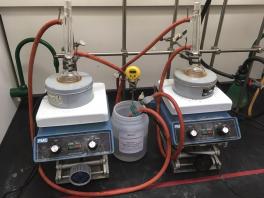An Inexpensive Aquarium Pump Water Recirculator for the Teaching Laboratory

Summary
The design and operation of a simple and inexpensive water recirculator is described, which can replace wasteful running water "tap-to-drain" applications such as providing cooling to Liebig-type (water jacket) condensers. The recirculator uses an inexpensive and easily acquired aquarium pump placed within a large plastic jar or bucket. Data is provided for the estimated water saved per hour when using the recirculator instead of running treated municipal water through the condenser and into the sewer system. An evaluation is provided for the conditions under which the system can operate unattended and when it may be necessary to add ice to keep the recirculating water cold enough to prevent solvent evaporation. The described water recirculator has been used successfully to replace conventional tap-to-drain cooling for Liebig-type condensers in undergraduate experiments carried out by over 300 students over four years.
Safety Precautions, Hazards, and Risk Assessment
The aquarium pump should be inspected regularly for any wear in its electrical cord. Otherwise, the only risk to the operator or property arises if the rubber hoses attached to the condenser are not secured properly. In this scenario, the pumped water can travel some distance (up to 2 meters), possibly causing a slip-and-fall hazard.
Teacher Recommendations or Piloting Data (if available)
If instructors wish, students can be challenged to consider the overall impact of the change from a tap-to-drain to recirculating water cooling system. Apart from the conservation of treated water, consideration should be given to the compromise that the aquarium pumps use electricity and, if ice is added, that there is a cost to running the ice-maker. If economic considerations are part of the analysis, students should research local cost to deliver treated municipal water (which normally includes a sewer levy) contrasted with the energy consumption of the aquarium pump (and, if applicable, the cost of any ice that is added).
Digital Object Identifier (DOI)
https://doi.org/10.59877/YZRS1943
Other notes/information
The flow rate within the pumped cooling loop is significantly faster (1500 L/h per manufacturer specifications) than is normally employed in tap-to-drain applications. As a consequence, it is essential to ensure that all hose connections at the pump and condenser(s) are tight and that appropriate tubing clamps are used.
File (PDF, PPT, image, etc)
Link to external
Creative Commons License

This work is licensed under a Creative Commons Attribution-NonCommercial-ShareAlike 4.0 International License.
